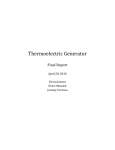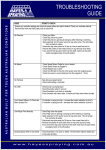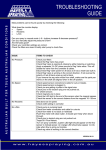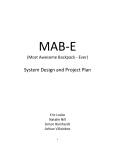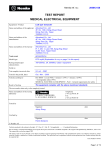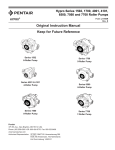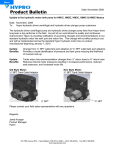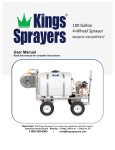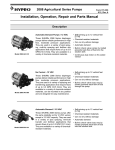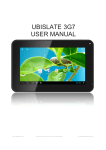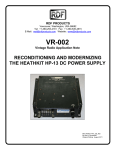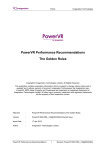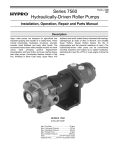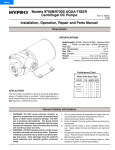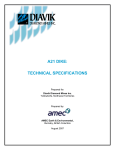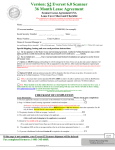Download Wood Burning Generator
Transcript
Wood Burning Generator Mid-Term Progress Report March 2, 2010 Kevin Jensen Drew Messick Jeremy Verzosa Table of Contents Requirements Specification .......................................................................................................................... 3 Project Overview........................................................................................................................................... 5 Project Status ............................................................................................................................................ 6 Budget Analysis ......................................................................................................................................... 8 Schedule Analysis .................................................................................................................................... 10 Block Diagram ......................................................................................................................................... 12 Functional Description of Blocks............................................................................................................. 13 System Progress and Accomplishments ..................................................................................................... 15 Thermosyphon Design and Progress ...................................................................................................... 16 Thermoelectric Generator Design and Progress..................................................................................... 19 Cooling System Design and Progress ...................................................................................................... 21 User Interface/Inverter Design and Progress ......................................................................................... 23 Encasement Design and Progress ........................................................................................................... 30 Appendices.................................................................................................................................................. 32 Appendix A: Thermosyphon Parts .......................................................................................................... 33 Appendix B: Thermoelectric Generator Parts ......................................................................................... 35 Appendix C: Cooling System Parts .......................................................................................................... 36 Appendix D: User Interface/Inverter Parts ............................................................................................. 39 Appendix E: Encasement Parts ............................................................................................................... 43 Appendix F: Circuit diagrams and results ............................................................................................... 45 2 Requirements Specification Background: There is a large interest in today’s market for sustainable energy. Consumers are looking for devices that can provide electricity to their home, not only when power is unavailable but also in addition to their normal usage. The trouble with most products is that they are complex, bulky and expensive. Additionally, energy sources for these generators are not always available (wind/solar/fossil fuels). What is needed is a low cost, storable, easy to use device that provides supplemental energy to the home or emergency electricity if the power is out. We believe that a generator using an already built fireplace as the energy source is the natural choice for this request. The major benefit of this generator is that the combustion chamber is already available and safe, users know how to use it and fuel is readily available. The Deliverables: There are five deliverables as listed below: 1. Working Prototype 2. System Specifications a. Design Concept b. Block Diagram c. CAD Drawing and Analysis 3. Circuit Schematics and Simulation Results 4. User’s Manual 5. Bill of Materials Principles of Operation: The user will begin by installing the generator to their existing fireplace. The device will not be permanent, but instead will be installed only when used. The actual generator will sit on the hearth outside of the fireplace. A device will extend into the fireplace to collect heat and transport it to the generator. Once a fire is built and the chamber reaches a sufficient temperature the generator will begin to produce electricity and notify the user that they can plug in a device. The user will then be able to plug in any electrical device which uses less than 150W of power to a standard NEMA Type B outlet. Special Restrictions: The generator must be considered safe with no parts exposed that could cut or burn the user. Additionally, the electrical aspects should present no risk of fire or shock. The NEMA Type B outlet should be properly grounded. Input: The input of the device is a wood burning fire in an open hearth fireplace. The heat from the fire will serve as the energy source for the electric generator. Closed stoves and gas burning fireplaces will not be supported. 3 Output: The generator’s output connector will consist of a NEMA Type B electrical outlet. The outlet will provide 125 VAC േ 15% and at least 1.5 A േ 10% at 60 Hz േ 0.5%. For comparison, most normal household electrical outlets in the United States provide approximately 125 volts and 15 amps at 60 Hz when connected to the power grid. Technical Requirements: The following requirements must be met. 1. Size – The device should be small and light enough to be carried by a single person. The generator should be no greater than 0.6 x 0.6 x 0.46 meters (2 x 2 x 1.5 feet). This does not include the device for collecting and transporting heat from the fire to the generator. 2. Weight – The device should not weigh more than 22.7 kg (50 lbs). 3. Installation – The generator will sit on the hearth and a device will be extended into the fire for heat collection. There will be no permanent attachments such as bolts or screws to be affixed prior to use. 4. Harmful Gases – The device should not compromise the existing effectiveness of the fireplace to route harmful gases (carbon dioxide, carbon monoxide, nitrogen oxides and aldehydes) out from the house. Due to the large variety of sensors needed along with the associated costs, this will be judged by visually observing if there is a change to the amount of smoke in the room when the device is in use compared to when it is not in use. 5. Nature of Fuel – The device will work with a fire built with wood logs (not wood chippings or sawdust). The user will not be required to cut the logs to certain dimensions, provided the logs will fit in the fireplace. 6. User Intervention – The user will be responsible for maintaining the fire. An indicator on the device will notify the user if the fire is not hot enough (sufficient power is not being produced; see Indicators and Controls). The device should not require the user to burn more than 25 pounds of wood per hour. 7. Indicators and Controls – The device will indicate visually (e.g. LED) to the user when enough electricity is being generated to run a device. Additionally, the user will be able to cut off power to the outlet by shutting off the device with a switch. 8. Electrical Safety – The electrical system must be grounded by a connection to an existing wall outlet’s ground. All internal wires should be able to handle the maximum amount of current in order to prevent electrical fires. Wire that is at least an AWG gage 10 nonmetallic insulated wire will provide this safety. 9. General Safety – Any exposed (outside of the fireplace) surface of the device should not exceed 43 degrees Celsius (110 °F) in order to prevent burning the user. 4 Project Overview 5 Project Status With the beginning of the spring semester, construction has officially begun on the wood burning generator prototype. Work commenced on the thermosyphon and the electrical components immediately after returning from the Christmas break. Delays in the thermosyphon caused work on the encasement, cooling system and thermoelectric generator to begin later than planned, but significant progress has been made in each component. A robust budget has allowed the team to remain under the $850 constraint. Figure 1: Wood Burning Generator Design Before work could begin on the thermosyphon, a major design change was made prior to finalizing the design. This change consisted of moving the pressure relief valve from before the thermoelectric condensing chamber to after it. This will allow cooler steam to transfer heat to the thermoelectric generators, rather than just steam that can eventually make it through the valve. This change was minor in regards to construction, but nonetheless delayed the start of building. Once construction began, the tanks (boiler, holding tank and thermoelectric generator condenser) took an extra five weeks to complete which further delayed completion. The thermosyphon is currently complete except for the condensing tubes which will be added after additional testing is completed. Unfortunately, construction of the thermoelectric generator and cooling system had to wait for the thermoelectric generator condenser to be complete before their designs could be tested. Additional thermosyphon testing will need to be completed before these components are permanently installed. The design changes from the thermosyphon did not affect the design of the thermoelectric generator. After the thermoelectric generator condensing chamber was completed the thermoelectric generators were temporarily attached to test their integration. This test was successful and after further testing of the thermosyphon, the generators will be permanently attached and their output will be tested. 6 The means of assembling the cooling system has been tested and will work. However, to allow further testing of the thermosyphon, the cooling system has been removed temporarily along with the thermoelectric generators. The only modification to the original design involves applying pressure downward onto the heat sinks. This pressure will increase the thermal conductivity between the thermosyphon, the thermoelectric generators and the cooling system. All the parts for the cooling system have been bought. Electrical construction is progressing at this stage. The user interface circuitry has been breadboarded and testing has commenced. The design has not changed from the original, except for a new Zener diode that has been purchased to account for the current flowing through the diode. Secondary testing is underway and will be finished soon. The inverter circuitry will be integrated along with the battery and LED circuitry and a PCB will be etched and tested before ordering a professional PCB. Construction of the encasement is near completion. One major design change includes switching the material from steel to wood due to weight and construction issues. This change will allow the encasement to be completed in much less time and for less money than before. Except for some additional hardware, all of the parts for the encasement have been bought. With construction underway, the team is behind schedule but under budget. The thermosyphon is complete except for the condensing tubes. The thermoelectric generator and cooling system have been successfully attached to the thermosyphon to test for integration. The electrical components are currently under construction and are being tested before integrating them with the rest of the device. Lastly, construction of the encasement is well under way and progressing smoothly. The team is confident that the prototype will be delivered working, on time and under budget at the end of the semester. Figure 2: Wood Burning Generator under Construction 7 Budget Analysis The budget as a whole is still within the required limits. As construction has begun, the amount of purchased parts has increased and a better idea of the final budget has emerged. The thermosyphon, cooling system and user interface remain over budget while the thermoelectric generator, inverter and encasement remain under budget. At this time, the team still has $124.93 not directly budgeted for parts. Table 1 shows an overview of the budget. Table 1: Budget Overview Sub Function Original Current $55.00 $215.00 $65.00 $60.00 $70.00 $35.00 $256.05 $205.36 $92.58 $47.22 $107.97 $15.89 Contingency $350.00 $124.93 Total $850.00 $850.00 Thermosyphon Thermoelectric Generator User Interface Inverter Cooling System Encasement Both shipping charges and taxation lead to the most changes in the budget. These expenses were either unknown or not included in the original budget, but rather have been added as they were encountered. Additionally, small ticket items such as thread seal tape and hardware were not included originally, and now are causing the expenses to increase. The change in material for the encasement caused the encasement budget to lower by about $15.00 because of the cost difference between wood and steel. As expected, these minor increases and decrease have not affected the ability for the team to stay under budget. A unique budgetary concern for the wood burning generator lies with safety. To ensure that the prototype is as safe as possible during operation, the faculty has allocated additional funds to the project that will not count towards the final cost. This safety oriented change includes the addition of another pressure relief valve that vents directly to the atmosphere. This will allow the system’s pressure to be relieved before it reaches a breaking point that could lead to possible injuries (See Thermosyphon Design and Progress for details). The additional pressure relief valve and associated tank flange add up to a cost of $22.83. One major component still remains to buy. The professional circuit board (PCB) needs to be ordered, but to prevent mistakes, an etched circuit board will be used for testing and the PCB will be ordered at a later date. The cost of the PCB should yield no surprises when the time comes to order it. In the event the wood burning generator goes over budget, there is an extra unspecified feature that can be removed in order to recoup some money. The current design calls for the boiler to be able to be removable for storage. This involves the inclusion of two union fittings and two brass ball valves in 8 the thermosyphon. These add up to an additional cost of $30.88, and can be returned if needed to stay under budget. With only a few more major components to purchase, the budget outlook is positive. The budget did increase due to the realities of shipping and taxation, but not so much that the budget was compromised. With the aid of the faculty, safety concerns can be addressed without making budgetary decisions that could lead to a dangerous prototype. Optional features will ensure that the budget can remain below the $850 limit. 9 Schedule Analysis Despite a lot of work going into making the schedule, the actual events of this semester have not resembled the original plan. Taking time to finalize the design and delays in the thermosyphon construction have been the main causes of getting behind. A revised schedule has been created which moves the completion of construction to three weeks later than originally planned. The first week of the semester was spent finalizing the design which immediately put the team behind one week. Once construction began (week of January 18), delays in the thermosyphon pushed the schedule back four weeks. Construction on the thermoelectric generator, encasement, and cooling device then began during the week of March 1. Work on the electrical components began one week after anticipated during the week of January 18 and will continue until its integration into the generator as a whole. This schedule is illustrated in a Gantt chart Figure 3 (yellow bars show updates to the schedule before spring break and the revised schedule after spring break). Figure 3: Spring Gantt Chart showing the original schedule (blue) and the revised schedule (yellow). In the revised schedule, some construction and testing will happen after spring break. During the first week after returning from break, additional testing will be performed on the thermosyphon to prepare it for completion as well as for attaching the thermoelectric generators and cooling system. At this same time, the encasement, inverter and user interface will continue to be built. The next week (week of March 22) the thermosyphon will be completed and the thermoelectric generators and cooling system will be attached to the thermosyphon. These three components along with the inverter and user interface will then be integrated into the encasement the same week. The last week of construction (week of March 29) will consist of testing the thermoelectric generators (the cooling 10 system is included in this test) and the electrical components. At this point, major construction and testing should be completed. At the beginning of the semester, a goal was set to have approximately 80% of the device completed by Spring Break. To gauge how much has actually been accomplished, each device was weighted based on the size and scope of an individual component compared to the device as a whole and on how much work will be required during construction. A percentage of completion could then be given to each component and a total percent complete could be calculated. Using this method, the team found that approximately 72% of the construction/testing is complete. Table 2 shows all of the estimated completion percentages along with their given weights. This falls short of our original goal, but given the setbacks encountered it is a satisfactory number. Table 2: Percent Completion of Construction Component Percent of Total Device Percent Complete Thermosyphon 40% 80% Thermoelectric Generator 10% 50% Cooling System 10% 80% Electrical Components 20% 60% Encasement 20% 75% Total 100% 11 72% Block Diagram Encasement Boundary Fireplace 100° C < T < 500° C Thermosyphon 100° C < T < 180° C User Interface Hot Side Heat Sink 100° C < T < 180° C 12 Thermoelectric Generator Excess heat (180° C without cooling) Cooling Device 12 VDC, 20 mA 14 VDC, 23 Amps Battery 12 VDC, 18 A Inverter 120 േ 10 VAC A > 1.5 Amps 60 േ .05 Hz Unit Outlet 12 Functional Description of Blocks Fireplace – The user’s fireplace will act as the combustion chamber and contain the wood burning fire. The fire will be required to provide temperatures between 100° C and 500° C. Input: Wood Output: Temperatures between 100° C and 500° C Thermosyphon – The thermosyphon will collect heat from the fire in a boiler changing liquid water to water vapor which will then exit the fireplace and deliver temperatures ranging from 100° C to 180° C. The vapor will condense in copper coils, be stored in a holding tank and then return to the boiler. Input: Temperatures between 100° C and 500° C Output: Temperatures between 100° C and 180° C Hot Side Heat Sink – The hot side heat sink will transfer the heat from the thermosyphon to the hot side of 10 thermoelectric generators (40mm x 40mm each). It will be maintained at temperatures between 100° C to 180° C. Input: Temperatures between 100° C and 180° C Output: Temperatures between 100° C and 180° C Thermoelectric Generator – The thermoelectric generator will use the temperature differential that exists between the hot side heat sink and the cold side heat sink to produce approximately 14 volts and 23 amps DC or 322 watts (10 individual thermoelectric generators providing 7 volts and 4.6 amps each assuming a temperature differential of 130° C, two sets in series of five in parallel). Input: Temperature between 100° C and 180° C Output: 14 Volts and 23 amps DC (322 watts) Excess heat (180° C without cooling) Cooling Device - The cooling device will remove 2149 W or more of heat from the thermoelectric generators. This will be achieved through forced convection by two fans over ten finned heat sinks. Input: Excess heat (180° C without cooling) Output: > 2149W heat removed. Battery – The battery will be charged by excess DC voltage produced by the thermoelectric generator. It will serve as a regulator as the output of the thermoelectric generator fluctuates. Input: 14 V and 23 A DC (322 W) Output: 12.7 V and 18 A DC (228.6 W) 13 Inverter – The inverter will convert the DC power from the thermoelectric generator or battery into AC power and step up the voltage. Input: 12 V and 18 A DC (216 W) Output: 120 10 VAC, greater than 1.5 Amps, 60 .05 Hz User Interface – This circuitry will control the flow of power to the outlet as well as indicate to the user when sufficient power is being supplied to the outlet. When the user switch is in the on position, power will be available and the user can plug in a device using 200 watts or less. When it is in the off position, no power will be supplied to the outlet. Additionally, a single indicator LED will light up when at least 12 volts is being supplied by the battery. Input: 12.7 V DC and 1.5 A, 60 .05 Hz User controlled switch Output: LED indicator Unit Outlet – The unit outlet is the standard household outlet (NEMA type B) that the user will plug their device into. For safety reasons the neutral pin will be connected to the metal frame of the device. Input: 110 VAC – 125 VAC, greater than 1.5 Amps, 60 േ .05 Hz Output: 110 VAC – 125 VAC, greater than 1.5 Amps, 60 േ .05 Hz 14 System Progress and Accomplishments 15 Thermosyphon Design and Progress One of the main reasons that the team is behind schedule is due to the thermosyphon. At the beginning of the semester some design changes were made which put off beginning construction for approximately one week. To compound this, problems found during construction, scheduling conflicts with a professional welder as well as lack of available time in the Mechanical Engineering Lab have plagued the thermosyphon. Almost all the parts for the thermosyphon have been purchased. The original design of the thermosyphon consisted of three main parts connected by piping. The boiler was located in the fireplace and allowed heat to be added to liquid water, turning it into steam. This vapor then traveled to the thermoelectric generator condensing chamber where some heat is extracted for conversion to electricity. The remaining heat was then removed by routing the vapor through an extension of copper pipe exposed to air. This condensed the vapor back into a liquid which was then stored in the holding tank. This holding tank was connected to the boiler. Both the boiler and the holding tank will have the same water level. This ensures that the boiler will never become “dry.” Figure 4: Original Thermosyphon Design Before construction even began, one major change was made to the thermosyphon. This consisted of putting the pressure relief valve after the thermoelectric condensing chamber rather than before it. This change allows any steam to enter the thermoelectric generator condensing chamber rather than only steam that meets the 180° C criteria. When steam in the chamber exceeds this temperature, the pressure relief valve will open and eject the steam into the condensing tubes, protecting the thermoelectric generators from overheating. This should allow the device to work even when the fire is not producing enough heat to raise the steam temperature above 180° C. This move naturally affected the physical design of the thermoelectric condensing chamber as well as the condensing tubes. 16 Figure 5: Original (left) and improved (right) pressure relief valve location. The new thermoelectric condensing chamber is 1.125 x 8.125 x 3.25 inches (0.02858 x 0.2064 x 0.08255 m). As before, the top of the chamber is made of copper onto which the thermoelectric generators will be attached. The pipe from the boiler attaches to the bottom as well as the pressure relief valve (150 psi). For added safety, an additional pressure relief valve (with a cracking pressure of 175 psi) will also be attached to the bottom. The 150 psi pressure relief valve is enclosed by another tank with three exits. These three exits connect to the copper condensing tubes. 3/8 inch tank flanges allow copper fittings to be directly attached to the pressure relief valve enclosure and to the holding tank. The top two flanges each connect to copper “T” fittings that allow two condensing tubes to be connected to each. The bottom flange prevents any liquid water from collecting in the pressure relief valve enclosure by connecting to another condensing tube that will go directly to the holding tank. All five condensing tubes connect to a single 3/8 inch tank flange in the top of the holding tank. Figure 6: Improved Thermosyphon Design (Left) and Current Construction (Right) 17 Construction has so far been defined by the fabrication of the tanks. The cutting and welding of metal has taken much longer than anticipated due to scheduling conflicts with someone qualified to do the welding. However, once the tanks were complete they were connected to one another quickly because this merely consisted of screwing pipes together. Figure 7: Current Level of Construction for the Thermosyphon A major concern is the check valve between the holding tank and the boiler. The one psi cracking pressure was assumed to be negligible during design, but this turned out to be a poor assumption. The weight of the water in the holding tank is insufficient to open the check valve and therefore the boiler may never be resupplied with liquid water. After much effort, a solution to the problem has not yet presented itself. In fact, it is not quite fully known whether it will be a problem or not. Because of these two factors construction will continue, assuming the valve works as designed, and the problem will only be revisited if indeed it becomes a problem during future testing. Despite construction taking a long time the tanks that are finished are high quality and function as desired. Pressure testing is underway on the completed section of the thermosyphon. All leaks so far have come from the connections, but have been readily fixed by adding plumbing tape and tightening the connections. All of the parts for the thermosyphon have been purchased with the exception of the condensing tubes and their associated fittings. All of which can be bought locally when needed. The thermosyphon has run into serious delays that affect the entire project. However, the design changes will make the wood burning generator a better product and were worth the additional time spent. 18 Thermoelectric Generator Design and Progress The thermoelectric generator design has not been modified from the original. Despite major changes in the thermosyphon design, those changes do not affect the layout or functionality of the thermoelectric generator. The thermoelectric generator has been laid out on the thermosyphon to check for any integration problems. As soon as testing of the thermosyphon is complete, the generator will be permanently attached. All of the parts for the thermoelectric generator have been bought. The original design of the thermoelectric generator calls for 10 individual thermoelectric generators to be arranged on a copper heat sink provided by the thermosyphon. The cooling system attaches to the top of these generators, increasing heat transfer across them which is converted to electricity. The individual thermoelectric generators are bonded to the thermosyphon’s copper heat sink and the cooling system’s aluminum heat sinks by use of a thermal paste. Figure 8 shows the interaction of the thermoelectric generator with the thermosyphon and the cooling system. Figure 8: Thermoelectric Generator interaction with the thermosyphon and cooling system. The individual thermoelectric generators are wired together in a configuration that produces the desired output voltage of greater than 12.9 volts. Each generator produces approximately 7 volts and 4.6 amps. When placed in series, the voltage of a thermoelectric generator is cumulative and the current remains constant. When in parallel, the current is cumulative and the voltage remains constant. Figure 9 shows the configuration that produces an output of approximately 14 volts and 23 amps. 19 Figure 9: Thermoelectric Generator Configuration No changes have yet been made to the design of the thermoelectric generator. The most likely change will involve modifications to the wiring configuration to get the proper voltage. This change will be easy to implement and not affect the budget since it solely consists of rewiring. Additional changes may become necessary once construction begins. All of the parts for the thermoelectric generator have been bought. For the generators themselves, 10 Thermal Enterprises HT1-12710 thermoelectric generators were purchased. Arctic Silver Ceramique Thermal Compound was chosen and purchased for the thermal paste. (Additional specifications for the generators and thermal paste can be found in Appendix B.) The wiring that will be used to connect the individual thermal electric generators together and to the user interface/inverter is included in the user interface/inverter budget and will be bought when construction begins. 10 shows the purchased thermoelectric generators laid out in the desired configuration with the heat sinks in place. Figure 10: Thermoelectric generators with heat sinks laid out in desired configuration. 20 Cooling System Design and Progress The cooling system will remove heat from the top of the thermoelectric generator. It consists of 10 finned heat sinks and two fans located directly above them. Each heat sink is attached to the top of one thermoelectric generator with thermal paste. The fans are attached to the inside of the top of the encasement and are powered by the battery circuitry. This configuration is shown in Figure Figu 11. Figure 11: Cooling System Design The only modification to the original cooling system design involves applying additional pressure onto the heat sinks. The pressure will be applied by flat metal straps, two per pair of heat sinks, which run in between the pins of the heat sinks. Wires will be attached to the ends of each strap and connected underneath the thermoelectric condensing chamber using worm clamps that have been cut cu open. The clamps will then be tightened to pr provide tension in the wires and thus add pressure to the heat sinks. Figure 12 illustrates this. Figure 12: Cooling System Integration Test 21 Figure 13: Heat Sink Pressure Test To test whether this method would provide the necessary pressure, a set of heat sinks was attached to the thermoelectric condensing chamber. The setup worked even better than expected. In fact, the wires were so tight that the chamber could even be picked up by the heat sinks (Figure 13). Additional tests that need to be performed include testing the fans to make sure they run off of the battery and testing the integration of the fans with the encasement. Unless the fans are broken they should have no trouble running off of the battery. The encasement integration test will ensure that the final installment of the cooling system into the encasement will go smoothly. After the thermosyphon is complete, the thermoelectric generators and the cooling system will be permanently attached and tested to ensure they work properly. 22 User Interface/Inverter Design and Progress The initial user interface breadboard was constructed with a 5.6 V, 0.5 W Zener diode. This caused a problem because the breakdown voltage was too low; allowing too much current to flow through the Zener diode practically burning it out. A 1N5351B 14V 5W Zener diode has been purchased and implemented into the circuit design and a place for it etched on a PCB. Testing to determining how much current flows through the Zener diode, as well as the battery, is shown in Tables 3 and 4 on pages 26 and 27, respectively. Table 3 is the test data for circuit 1, which is the original schematic. Table 4 is the test data for circuit 2 which is the updated schematic. The new circuit design is shown in Figure 16 on page 25 and the original design is shown in Figure 24 in Appendix F. It is good to point out that both circuits force more current, 100mA, through the Zener diode when the TEG voltage is too high. Another set of tests is being run with an increased resistance before the Zener diode to limit the current through it. As of now, Table 4 is the most recent set of test data. It is important to point out the major successes of these tests. The tests show a current flow through both the battery and the Zener diode. More importantly, the Zener diode current flows when the14V breakdown voltage is reached. Also, as the voltage at the battery is low (approx. 10 – 11V) current is flowing through the battery when the TEG voltage is high. This is important to show that the battery will charge when the voltage is low and the TEG voltage is supplying ample amounts of power. The current that is negative on the tables just means that the current is flowing to and through the battery power supply due to the fact that the leads on the multimeter were reversed. The battery is still going to provide or supplement power to the inverter when the thermoelectric generator power is not sufficient. The battery that was selected and purchased was a 12 V 15 Ah SLA (sealed lead acid) battery and will be charged as needed. The battery will be protected by the Zener diode. The Zener diode breakdown voltage is 14 V and should allow current to flow when the voltage at the node above the diode reaches 14 V. The LED is not illuminated when the voltage drops below 11.3 volts, which is close to the desired 12 volts. However, a discharged battery is considered to be 11.9 volts. Changes will be made to raise this “threshold” to prevent the battery from discharging too drastically. The LED informs the user when the voltage of the battery drops below the 11.3 V. 12 volts is the desired requirement keep the battery from entering into severe discharge. The inverter has been integrated with the circuitry and tested in the encasement for size requirements. Figures 19 and 20 (page 29)show that there sufficient room for the electrical components including the inverter, battery and circuit board. 23 Figure 14: Etched Circuit Board Figure 15: Breadboard of Circuit 24 J2 Inve rte r D2 Ke y = Sp a c e 75Ω 1N 4001GP R5 30Ω R4 5Ω V2 T EG C1 10F D1 1N 964B V1 B a tte ry J1 Ke y = A LM7812CT Fa n 75Ω Fa n1 1 LINE VREG VOLTAGE R1 10200Ω COMMON C2 330µF Q1 75Ω B JT _N PN _V IR T U AL R2 12600Ω LED 1 R3 150Ω Figure 16: Circuit 2 **R4 and R5 are the only values that have changed from the 2nd round tests on page 44. 25 Table 3: 3rd Round Testing with 14V 5W 1N5351B Zener Diode Battery voltage (V) --> 10 11 12 26 TEG voltage Battery Zener TEG voltage Battery Zener TEG voltage Battery (V) Current Current (V) Current Current (V) Current 0 0.0040 0.0000 0 0.0044 0.0000 0 0.0091 5 0.0040 0.0000 5 0.0044 0.0000 5 0.0091 10 0.0040 0.0000 10 0.0044 0.0000 10 0.0091 11 -0.0023 0.0000 11 0.0045 0.0000 11 0.0091 12 -0.0107 0.0000 12 -0.0002 0.0000 12 0.0091 13 -0.0113 0.0000 13 -0.0103 0.0000 13 -0.0021 14 -0.0117 0.0000 14 -0.0115 0.0000 14 -0.0103 15 -0.0211 0.0009 15 -0.0118 0.0071 15 -0.0116 16 -0.0352 0.0300 16 -0.0186 0.0352 16 -0.0118 17 -0.0534 0.0580 17 -0.0331 0.0564 17 -0.0186 18 -0.0484 0.0860 18 -0.0511 0.0842 18 -0.0324 19 -0.0707 0.0942 19 -0.068 0.1141 19 -0.0492 20 -0.0825 0.1352 20 N/A N/A 20 N/A *Negative numbers only represent that current is flowing through the battery due to polarity of multimeter during tests 26 Zener Current 0.0000 0.0000 0.0000 0.0000 0.0000 0.0000 0.0000 0.0071 0.0332 0.0591 0.0845 0.0980 N/A Battery voltage (V) --> Table 4: 3rd round testing with 14V 5W 1N5351B Zener diode 13 14 27 TEG voltage (V) 0 5 10 11 12 13 14 15 16 17 18 19 Battery Current 0.0123 0.0123 0.0123 0.0123 0.0123 0.0123 0.0073 -0.0103 -0.0116 -0.0118 -0.0159 -0.0308 Zener Current 0.0000 0.0000 0.0000 0.0000 0.0000 0.0000 0.0000 0.0090 0.0354 0.0562 0.0791 0.1103 TEG voltage (V) 0 5 10 11 12 13 14 15 16 17 18 19 20 N/A N/A 20 Battery Current 0.0163 0.0180 0.0186 0.0190 0.0192 0.0193 0.0136 -0.0101 -0.0117 -0.0120 -0.0146 Zener Current 0.0041 0.0060 0.0073 0.0073 0.0073 0.0073 0.0083 0.0363 0.0543 0.0833 0.1082 Zener too hot Zener too hot *Another test is shown and graphed in Appendix F ** Negative numbers only represent that current is flowing through the battery due to polarity of multimeter during tests 27 The graphs below represent graphically the results from the 3rd round tests. The legends indicate the voltage of the battery for each test. The first graph (Figure 17) shows negative voltages, but that is only due to reversal of polarity of multimeter during tests. The second graph (Figure 18) illustrates the current flowing through the battery. 3rd Round Tests 0.0400 Battery Current (A) 0.0200 0.0000 10V -0.0200 11V -0.0400 12V -0.0600 13V -0.0800 14V -0.1000 0 5 10 15 20 25 Thermoelectric Generator Voltage (V) Figure 17: Results of 3rd Round Tests 3rd Round Tests 0.1600 Zener Diode Current (A) 0.1400 0.1200 0.1000 Series1 0.0800 Series2 0.0600 Series3 0.0400 Series4 0.0200 Series5 0.0000 0 5 10 15 Thermoelectric generator voltage (V) Figure 18: Results of 3rd Round Tests 28 20 25 Figures 19 and 20 demonstrate a rough estimate of how the electrical components will be placed inside the encasement. There will be some sort of aid to help keep the circuit board in place. Once the hinged panel is in place, the supports for the PCB will be designed. Additionally, the circuit board shown is not the professional board that will be used in the final prototybe, but instead just the one etched in the project lab. Figure 19: Electrical components inside encasement Figure 20: Electrical components inside encasement 29 Encasement Design and Progress The encasement will house all the internal components of the wood burning generator. Insulation will be used around the thermoelectric condensing chamber and around the holding tank to keep the electronics from overheating and the surface of the encasement from burning the user. One major design change has been implemented concerning the material of the encasement. Originaly, the encasement was to be made out of 1/8 inch steel sheet. However, the weight of the thermosyphon boiler (made out of 1/8 inch steel sheet) made the team reconsider this choice. To replace the steel sheet, the encasement will be made out of 5.0 mm utility plywood. The plywood will be painted on the inside and outside with a high heat paint to protect it. Figure 21: Encasement Panels (Left) and Assembled Encasement (Right) Parts for the encasment have been cut out and assembled. Brackets were made from scrap metal and were used to bolt the wooden panels together. The two lower side panels are hinged to allow easy access to the holding tank for adjusting the water level and to the electronics for testing and maintenance. Another major part of the encasement is the insulation that surrounds the thermoelectric condensing chamber and the holding tank. These pieces of insulation have been cut out and tested for fit. In testing it was found that the insulation does not perfectly seal off each section of the device from one another. This could be fixed by either filling the gaps with a spray foam, recutting the pieces to fit better or a combination of the two. Another minor issue has arisen concerning the hinged panels on the lower section. The first attempt at installing the hinges Figure 22: Encasement with Thermosyphon was unsuccessful. The wooden panels were 30 splitting and the door did not behave properly (see Figure 23). To fix this , notches will be cut in the panels to allow room for the hinge to behave properly. Additionally, drilling pilot holes for the hinge fasteners will keep the wood from splitting. Figure 23: Hinge Problem (Left) and Proposed Solution ((Right) 31 Appendices 32 Appendix A: Thermosyphon Parts Part Name: Brass ASME Pop-Safety Valve for High Temp 1" NPT Male Supplier: McMaster-Carr Catalog Number: 9889K59 Datasheet: Unavailable Specifications: Opens at 150 PSI Operates at -40° F to 400° F Maximum flow is 659 ft3 / minute Connection is 1” NPT Male Part Name: Brass Piston Check Valve Spring-Loaded, 1" NPT Female Supplier: McMaster-Carr Catalog Number: 7746K83 Datasheet: Unavailable Specifications: Maximum Pressure is 200 psi @ 225° F Cracking Pressure: 1 psi Temperature Range: 33° to 225° F Connections are 1” NPT Female Part Name: Brass Ball Valve Supplier: Lowe’s Home Improvement Manufacturer: American Valve Catalog Number: M100 Datasheet: Attached 33 1 .8 0 0 .6 4 5 . 0 1 0 1 www.a me ric a nv a lve . co m Industry-Leading Innovation M100 Brass Ball Valve One valve does it all! FEATURES: ▪ 100% Full Port Opening ▪ Solid Ball ▪ Threaded Ends ▪ Most versatile valve available ▪ Teflon® Seats ▪ Teflon® Packing RATINGS: 150 psi WSP 400 psi WOG ▪ CSA ½G, 5G, 125G gas ratings ( ½˝-2˝) ▪ UL-listed for flammable liquids (¼˝-2˝) ▪ FM for fire protection (½˝-2˝) ▪ Conforms to MSS-SP-110 Part Options - T Handle - Locking Handle Material Handle Nut Steel Handle Steel Stem Gland Screw Brass ASTM B-16 Packing Teflon® (PTFE) Stem Brass ASTM B-16 Body Forged/Cast Brass Ball Brass/Forged Brass (chrome Plated) DIMENSIONS: A End to End 1/4 3/8 1/2 3/4 1 1 1/4 1 1/2 2 2 1/2 3 4 1 11/16 1 11/16 1 5/16 2 1/2 3 3 7/16 3 5/8 4 1/4 6 6 1/2 7 3/4 B Center of Port to Top 1 3/4 1 3/4 1 5/8 2 1/16 2 1/4 2 5/8 2 3/4 3 7/16 4 3/4 5 1/8 6 C Overall Height 2 1/4 2 1/4 2 1/8 2 7/8 3 1/4 3 3/4 4 1/8 5 6 5/8 7 1/4 9 D Center of Valve to End of Handle 3 1/2 3 1/2 3 3/8 4 3/4 4 3/4 5 1/4 5 1/4 5 1/2 9 5/8 9 5/8 10 1/2 E Port Opening 3/8 3/8 9/16 3/4 1 1 1/4 1 1/2 2 2 1/2 3 4 Weight 0.3 0.3 0.45 0.8 1.2 2 2.7 3.25 7.85 8.65 16.3 Approx. CV 12 12 20 42 78 132 207 346 470 590 670 2 Appendix B: Thermoelectric Generator Parts Part Name: Thermoelectric Generator Supplier: Thermal Enterprises Manufacturer: Thermal Enterprises Catalog Number: HT1-12710 TEG Datasheet: Unavailable Specifications: 40mm x 40mm x 3.3mm Operates from 0-16 volts DC and 0-10.5 amps Operates from -60 deg C to +225 deg C Fitted with 6-inch Teflon insulated leads Perimeter sealed for moisture protection Part Name: Thermal Grease Supplier: Newegg.com Manufacturer: Arctic Silver Model Number: Ceramique Datasheet: Unavailable Specifications: See Below 35 Appendix C: Cooling System Parts Part Name: Fan Supplier: Newegg.com Manufacturer: Link Depot Model Number: 8025-B Datasheet: Unavailable Specifications: Size: 80x80x25mm Current: 0.16A Air Flow: 38.2CFM Speed: 3000RPM Power: 1.92W Bearing: One ball bearing Voltage: 12VDC Noise: 32.1dBA Name: Heat Sink Supplier: Cool Innovations Model Number: 3-151511U Datasheet: Attached 36 1.5” X 1.5” U TYPE MODERATE PIN CONFIGURATION 1.50 Moderately Configured Aluminum Pin Fin Heat Sinks for Fansink Applications • Designed for 40 mm fan (predrilled mounting holes) • Round pin fin configuration generates optimal performance in impingement cooling mode • Forged from highly conductive aluminum • Lapped to achieve exceptional base surface finish and flatness • Heat sinks’ height can be customized to any dimension between 0.2” to 1.1” • Plating options: Anodize (black/clear), Electroless Nickel • Fan sold separately • RoHS compliant 1.50 1.23 1.23 0.07 DIA. H 0.120 DIA. THRU 82° CSK 0.235 O.D 2 PLACES 0.08 Length in(mm) Width in(mm) Height in(mm) Weight lbs(g) # of pins TR (°C/W) (40mm Fan) P/N 3-151502UBFA 1.50(38.1) 1.50(38.1) 0.20(5.1) 0.0229(10.4) 121 3.29 3-151503UBFA 1.50(38.1) 1.50(38.1) 0.30(7.6) 0.0275(12.5) 121 1.80 3-151504UBFA 1.50(38.1) 1.50(38.1) 0.40(10.2) 0.0320(14.5) 121 1.49 3-151505UBFA 1.50(38.1) 1.50(38.1) 0.50(12.7) 0.0365(16.6) 121 1.17 3-151506UBFA 1.50(38.1) 1.50(38.1) 0.60(15.2) 0.0411(18.6) 121 0.98 3-151507UBFA 1.50(38.1) 1.50(38.1) 0.70(17.8) 0.0456(20.7) 121 0.85 3-151508UBFA 1.50(38.1) 1.50(38.1) 0.80(20.3) 0.0501(22.7) 121 0.75 3-151511UBFA 1.50(38.1) 1.50(38.1) 1.10(27.9) 0.0637(28.9) 121 0.60 Impingement Cooling Please see Disclaimer at www.coolinnovations.com www.coolinnovations.com • [email protected] • Tel: (905) 760-1992 • Fax: (905) 760-1994 HYPRO HYPRO BALL 1B & 1S BALL BALL 1B & 1S BALL BALL 1B & 1S BALL BALL S S S HYPRO HYPRO HYPRO HYPRO BALL BALL BALL BALL BALL BALL S S S S S HYPRO HYPRO HYPRO HYPRO HYPRO BALL BALL BALL BALL BALL BALL BALL BALL Bearing Type 12 12 12 12 12 12 12 12 12 12 12 12 12 12 12 5 5 5 5 5 5 5 5 5 5 5 5 5 5 5 12 12 12 12 12 12 12 12 12 12 12 12 12 Volts (V) 0.12 0.12 0.08 0.08 0.10 0.10 0.10 0.12 0.12 0.12 0.15 0.12 0.08 0.10 0.12 0.14 0.16 0.29 0.40 0.12 0.14 0.16 0.29 0.40 0.29 0.12 0.14 0.16 0.29 0.29 0.05 0.07 0.08 0.13 0.11 0.05 0.07 0.11 0.08 0.13 0.10 0.15 0.15 Current (A) 1.44 1.44 0.96 0.96 1.20 1.20 1.20 1.44 1.44 1.44 1.80 1.44 0.96 1.20 1.44 0.70 0.80 1.45 2.00 0.60 0.70 0.80 1.45 2.00 1.45 0.60 0.70 0.80 1.45 1.45 0.60 0.84 0.96 1.56 1.32 0.60 0.84 1.32 0.96 1.56 1.20 1.80 1.80 Power (W) AT= Terminals AW= Wires AD0412MX-D52 AD0412HX-D50 AD0412LB-D50 AD0412LB-D50(S) AD0412LB-D52 AD0412MB-D50 AD0412MB-D50(S) AD0412MB-D52 AD0412HB-D50 AD0412HB-D50(S) AD0412HB-D52 AD0412HB-D56 AD0412LS-D50 AD0412MS-D50 AD0412HS-D50 AD0405LX-C50 AD0405MX-C50 AD0405HX-C50 AD0405HX-C52 AD0405DB-C50 AD0405LB-C50 AD0405MB-C50 AD0405HB-C50 AD0405HB-C52 AD0405HB-C56 AD0405DS-C50 AD0405LS-C50 AD0405MS-C50 AD0405HS-C50 AD0405HS-C56 AD0412DX-C50 AD0412LX-C50 AD0412MX-C50 AD0412MX-C53 AD0412HX-C50 AD0412DB-C50 AD0412LB-C50 AD0412LB-C51 AD0412MB-C50 AD0412MB-C52 AD0412HB-C50 AD0412HB-C52 AD0412HB-C53 Model Part Number NOTE B=Ball S=Sleeve X= Hypro 40 X 40 X 15 40 X 40 X 15 40 X 40 X 15 40 X 40 X 15 40 X 40 X 15 40 X 40 X 15 40 X 40 X 15 40 X 40 X 15 40 X 40 X 15 40 X 40 X 15 40 X 40 X 15 40 X 40 X 15 40 X 40 X 15 40 X 40 X 15 40 X 40 X 15 40 X 40 X 20 40 X 40 X 20 40 X 40 X 20 40 X 40 X 20 40 X 40 X 20 40 X 40 X 20 40 X 40 X 20 40 X 40 X 20 40 X 40 X 20 40 X 40 X 20 40 X 40 X 20 40 X 40 X 20 40 X 40 X 20 40 X 40 X 20 40 X 40 X 20 40 X 40 X 20 40 X 40 X 20 40 X 40 X 20 40 X 40 X 20 40 X 40 X 20 40 X 40 X 20 40 X 40 X 20 40 X 40 X 20 40 X 40 X 20 40 X 40 X 20 40 X 40 X 20 40 X 40 X 20 40 X 40 X 20 Frame Dimensions (mm) 7000 8000 6000 6500 6000 7000 7500 7000 8000 8500 8000 8000 6000 7000 8000 5700 6300 7500 7500 4200 6000 6500 7800 7800 7800 3700 5700 6300 7500 7500 3700 6000 6700 6700 7500 4200 6200 6200 6900 6900 7800 7800 7800 Speed (RPM) 8.1 9.2 6.8 7.3 6.8 8.1 8.5 8.1 9.2 10.2 9.2 9.2 6.8 8.1 9.2 7.2 7.8 9.2 9.2 4.9 7.2 8.1 9.9 9.9 9.9 4.7 7.2 7.8 9.2 9.2 4.7 7.5 8.3 8.3 9.6 4.9 7.7 7.7 8.5 8.5 10.1 10.1 10.1 Air Flow (CFM) 0.210 0.287 0.161 0.183 0.161 0.210 0.231 0.210 0.287 0.298 0.287 0.287 0.161 0.210 0.287 0.142 0.171 0.250 0.250 0.080 0.142 0.171 0.256 0.256 0.256 0.064 0.142 0.171 0.250 0.250 0.064 0.154 0.180 0.180 0.240 0.080 0.165 0.165 0.190 0.190 0.263 0.263 0.263 Pressure (Inches) ADDA USA DC FAN SPECIFICATIONS 31.8 39.3 30.3 30.6 30.3 31.8 33.5 31.8 39.3 39.8 39.3 39.3 30.3 31.8 39.3 22.4 26.3 31.0 31.0 16.5 22.4 27.0 31.9 31.9 31.9 10.0 22.4 26.3 31.0 31.0 10.0 23.9 27.5 27.5 31.0 16.5 25.0 25.0 28.5 28.5 31.9 31.9 31.9 27 27 27 27 27 27 27 27 27 27 27 27 27 27 27 28 28 28 28 28 28 28 28 28 28 28 28 28 28 28 27 27 28 28 27 27 28 28 28 28 28 28 28 Noise Weight (dB/A) (g) 2 0,6 0,6 0,6 2 0,6 0,6 2 0,6 0,6 2 0,6 0,6 0,6 0,6 0,6 0,6 0,6 2 0,6 0,6 0,6 0 2 6 0 0,6 0,6 0 6 0,6 0,6 0,6 3 0,6 0 0,6 1,2 0,6 2,3 0,6 2 3 Features Available 500 500 500 500 500 500 500 500 500 500 500 500 500 500 500 500 500 500 500 500 500 500 500 500 500 500 500 500 500 500 500 500 500 500 500 500 500 500 500 500 500 500 500 44.00 44.00 44.00 44.00 44.00 44.00 44.00 44.00 44.00 44.00 44.00 44.00 44.00 44.00 44.00 36.96 36.96 36.96 36.96 36.96 36.96 36.96 36.96 36.96 36.96 36.96 36.96 36.96 36.96 36.96 36.96 36.96 36.96 36.96 36.96 36.96 36.96 36.96 36.96 36.96 36.96 36.96 36.96 Units Per Box Box Wt. (lbs.) ALL RIGHTS RESERVED UL,CUL,TUV,CE UL,CUL,CE UL,CUL,CE UL,CUL,CE UL,CUL,TUV,CE UL,CUL,CE UL,CUL,CE UL,CUL,TUV,CE UL,CUL,CE UL,CUL,CE UL,CUL,TUV,CE UL,CUL,CE UL,CUL,CE UL,CUL,CE UL,CUL,CE UL,CUL,TUV,CE UL,CUL,TUV,CE UL,CUL,TUV,CE UL,CUL,TUV,CE CE UL,CUL,TUV,CE UL,CUL,TUV,CE UL,CUL,TUV,CE UL,CUL,TUV,CE CE CE UL,CUL,TUV,CE UL,CUL,TUV,CE UL,CUL,TUV,CE CE UL,CUL,CE UL,CUL,TUV,CE UL,CUL,TUV,CE UL,CUL,TUV,CE UL,CUL,TUV,CE UL,CUL,CE UL,CUL,TUV,CE UL,CUL,TUV,CE UL,CUL,TUV,CE UL,CUL,TUV,CE UL,CUL,TUV,CE CE UL,CUL,TUV,CE Safety Approvals Appendix D: User Interface/Inverter Parts Part Name: Battery Supplier: atbatt.com Manufacturer: Amstron Model Number: AP-12180NB Datasheet: Unavailable Specifications: See Below Specifications Chemistry Lead Acid Voltage 12 Capacity 18,000 mAh / 18 Ah Rating 216 Whr Connector R Terminal Length 7.13 inch / 18.11 cm Width 3.03 inch / 7.70 cm Height 6.57 inch / 16.69 cm Color Gray Weight 11.02 lb / 4,998.56 g Warranty 1 Year UPC Code 880487220647 39 Part Name: Inverter Supplier: Buy.com Manufacturer: Tripp-Lite Model Number: PV375 Datasheet: Unavailable Specifications: See Below General Specifications 2.2 lbs DC to AC power inverter - external Weight: Device Type: Miscellaneous Cables Included: Manufacturer Warranty Service & Support: Service & Support Details: Power Device Input Connector(s): Output connector(s): More Information Shipping Weight (in pounds): Product in Inches (L x W x H): Assembled in Country of Origin: Origin of Components: 1 x power cable 1 year warranty Limited warranty - 1 year 1 x automobile cigarette lighter 2 x power NEMA 5-15 2.25 6.0 x 3.0 x 4.0 Imported Imported 40 145 Adams Avenue, Hauppauge, NY 11788 USA Tel: (631) 435-1110 • Fax: (631) 435-1824 Appendix E: Encasement Parts Part Name: Encasement Exterior (Utility Plywood) Supplier: Lowe’s Datasheet: Unavailable Specifications: Thickness: 5.2mm Area: 4 x 8 Feet Name: Insulation Supplier: Lowe’s Manufacturer: Dow Model Number: 263063 Datasheet: Unavailable Specifications: See Below Reduced energy loss- lower heating & cooling bills High R-value Unsurpassed durability Moisture resistant facers Lightweight, easy to install Insulation Type: Polyisocyanurate Thickness (Inches): 0.5 Length (Feet): 8.0 Width (Feet): 4.0 R-Value: 3.0 Installation Instructions included: Yes Weather Resistant Barrier: 43 Yes Name: Aluminum Scrap Metal Supplier: Harding University ( Physical Resources) Manufacturer: Unknown Model Number: Unknown Datasheet: Unavailable Part Name: Worm Clamp, ¼” Supplier: Lowe’s Home Improvement Manufacturer: King Seal Fastener Technology Model Number: BCMM4SS09P10 Datasheet: Unavailable Part Name: Picture Wire Supplier: Unknown Manufacturer: Unknown Model Number: Unknown Datasheet: Unavailable 44 Appendix F: Circuit diagrams and results J2 Inve rte r D2 Ke y = Sp a ce 75Ω 1N 4001GP R5 20Ω R4 10Ω V2 T EG C1 10F D1 1N 964B V1 Ba tte ry J1 Ke y = A LM7812CT Fa n 75Ω Fa n1 1 LINE VREG VOLTAGE R1 10200Ω COMMON C2 330µF Q1 75Ω BJ T _N PN _VIR T U AL R2 12600Ω LED 1 R3 150Ω Figure 24: Circuit 1 **For the circuit above R4 and R5 are the only differences from the circuit on page 25. 45 Battery voltage (V) --> 10 46 TEG voltage (V) 0 5 10 11 12 13 14 15 16 17 18 19 20 Table 5: 2nd round testing with 14V 5W 1N5351B Zener diode 11 Battery Current 0.0040 0.0040 0.0040 -0.0010 -0.0102 -0.0113 -0.0119 -0.0187 -0.0293 N/A N/A N/A N/A Zener Current 0.0000 0.0000 0.0000 0.0000 0.0000 0.0000 0.0000 0.0120 0.0361 N/A N/A N/A N/A TEG voltage (V) 0 5 10 11 12 13 14 15 16 17 18 19 20 46 Battery Current 0.0044 0.0044 0.0044 0.0045 -0.0021 -0.0103 -0.0115 -0.0118 -0.0179 N/A N/A N/A N/A Zener Current 0.0000 0.0000 0.0000 0.0000 0.0000 0.0000 0.0000 0.0103 0.0397 N/A N/A N/A N/A 12 TEG voltage (V) 0 5 10 11 12 13 14 15 16 17 18 19 20 Battery Current 0.0091 0.0091 0.0091 0.0091 0.0091 -0.0001 -0.0100 -0.0116 -0.0118 -0.0224 N/A N/A N/A Zener Current 0.0000 0.0000 0.0000 0.0000 0.0000 0.0000 0.0000 0.0128 0.0409 0.1136 N/A N/A N/A Battery voltage (V) --> Table 6: 2nd round testing with 14V 5W 1N5351B Zener diode 13 14 47 TEG voltage (V) 0 5 10 11 12 13 14 15 16 17 18 19 20 Battery Current 0.0123 0.0123 0.0123 0.0123 0.0123 0.0123 0.0022 -0.0099 -0.0116 -0.0121 N/A N/A N/A Zener Current 0.0000 0.0000 0.0000 0.0000 0.0000 0.0000 0.0000 0.0156 0.0475 0.1010 N/A N/A N/A 47 TEG voltage (V) 0 5 10 11 12 13 14 15 16 17 18 19 20 Battery Current 0.0178 0.0184 0.0186 0.0187 0.0188 0.0187 0.0187 0.0054 -0.0097 -0.0119 -0.0212 Zener Current 0.0056 0.0061 0.0064 0.0064 0.0064 0.0064 0.0064 0.0117 0.0460 0.1110 0.1910 Zener too hot Zener too hot It is important to point out that the negative voltages from Tables 5 and 6 and in Figures 25 and 26 represent current that is flowing through the battery. The legend (for both graphs below) indicates the different voltages of the battery. 2nd Round Tests 0.0300 Battery Current (A) 0.0200 0.0100 10V 0.0000 11V -0.0100 12V -0.0200 13V -0.0300 14V -0.0400 0 2 4 6 8 10 12 14 16 18 Thermoelectric Generator Voltage (V) Figure 25: Battery Current with battery voltages from 10V – 14V 2nd Round Tests 0.2500 Zener diode current 0.2000 0.1500 Series1 Series2 0.1000 Series3 Series4 0.0500 Series5 0.0000 0 5 10 15 20 Thermoelectric generator voltage Figure 26: Zener Diode Current with battery voltages from 10V – 14V 48
















































